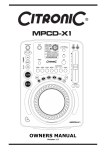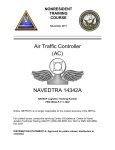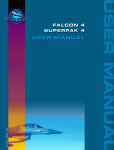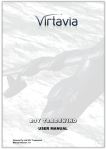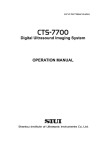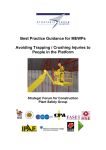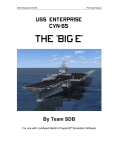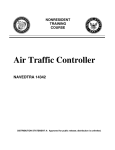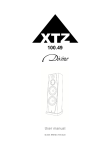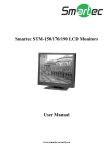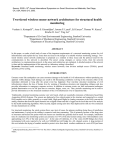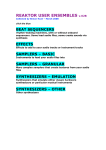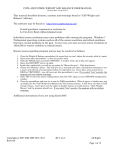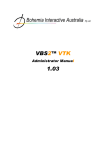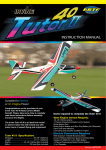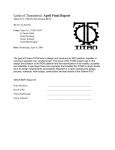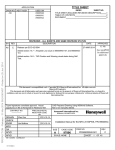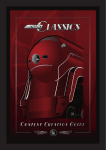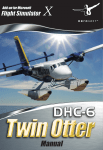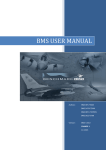Download F/A-18C Cockpit version 3.0
Transcript
Version 1.2
F/A-18C Cockpit version 3.0
User manual
Add-on created by
Aeyes
Qawa
JanHas
for FreeFalcon5 on Falcon 4.0
Released March 2009
WWW.COCKPITS.NL
U.S. Navy photo by Mass Communication specialist 1st Class John M. Hageman
Table of Contents
Title
- Index
- Chapter 1
Page
- 2
Installation and features
- 3
- Chapter 2 Functionality Description
- Front panels
- Front Left / Front Right panels
- Left / Right side panels
- Detailed panels
- 5
- 7
- 9
- 11
- Chapter 3 Checklists
- Preflight
- Engines Startup
- Weapons/ Sensors
- Before Taxi
- Taxi
- Before Take-off
- Take-off
- Air Refueling
- Carrier Landing
- Landing Pattern drawing
- 13
- 15
- 16
- 16
- 16
- 17
- 17
- 18
- 19
- 20
- Chapter 4 Carrier Takeoff
- General information
- Catapult Hook-up
- 21
- 21
- Chapter 5 Carrier Landing
- Carrier landing description
- IFLOLS
- Glidesclope And Airspeed Corrections
o Over Powered
o Under Powered
o Power OK
- Lineup Corrections
- Carrier Approach Notes
- Wave-off
- Night Operations
- 23
- 26
- 29
- 29
- 30
- 30
- 31
- 32
- 32
- 33
- Chapter 6 Delta Procedures
- Delta Easy
- Delta Clean
- 34
- 34
- Chapter 7 Naval Aviator stories
- Ring_Wraith
- Shadow
- 35
- 39
- Chapter 8
- 42
- Credits
Brevity codes and Abbreviations
- 62
CHAPTER 1: Installation instructions and features
2D and 3D fully clickable widescreen Cockpit in 1920 x 1200 resolution.
This version is intended for Falcon 4.0 with Freefalcon 5.
Installation
Step 1 Step 2 Step 3 -
Run the FA18C_v3.0 installer.
Select install, reinstall completely or look for update.
Start Falcon and select an F/A-18C Hornet to fly
Settings
These are recommended settings, with and without use of TrackIR:
Step 1 Run the FFViper Config Editor in your FreeFalcon5 dir
Step 2 Point it to your FreeFalcon5/FFViper.exe
Step 3 Go to ‘Cockpit settings’
Step 4 3Dcockpit FOV – Set to 60 (Default)
Step 5 Color MFD’s – disable
Step 6 Click Apply
Features and tips
2D cockpit:
Graphics
This install allows autoscaling, therefor it is possible to fly in lower resolutions
like 1680 x1050 or 1440x900. The default resolution is 1920x1200.
Photorealistic cockpit with as real as possible functionality, within the limits of
the Falcon simulator software.
ADI
The left DDI has a digital ADI, to be enabled on the HI/MPCD (Horizontal
Indicator/Multi Purpose Color Display).
Kneeboards
The right kneeboard has 12 pages of browsable checklists for preflight and
rampstart, ETR (Enemy Treat Ranges), refueling checklist, landing checklists.
The left kneeboard is disabled, FF5 allows multiple kneeboards.
HI/MPCD (Horizontal Indicator/Mulitipurpose Color Display)
Has a moving map in the center, it can be enabled by pushing the L4MAP button.
Has a digital HSI function, enabled by selecting the left upper knob and setting it
to NORM.
Has a full 3rd display for various data, mainly used as FCC page for Situational
Awareness.
Nightlighting
On the Internal Lights panel at the right down side you can enable floodlight by
selecting either the FLOOD switch or the FLOOD BRT knob.
For enabling Instruments lights and backlit panels you hit keys Shift-2 and you
turn the 'CONSOLES' knob to BRT.
Extra functionality panel
When keys Shift-1 are selected you will get a panel with extra large HUD/display
data, and complete functionality for handling the DED content and navigation.
Rampstart
A full rampstart is possible, complete checklists on the right knee. Note that
double engine rampstart is broken in current Red Viper version.
FF5 allows double engine rampstart again.
Brevity codes
Checklists, clicking down twice from the 12 o’clock view will bring you to a large
and complete NATO brevity code list for accurate communications.
3D cockpit:
Functionality
Fully clickable (although most switches will not move) and gauges/instruments
operational. See chapter 2 for a full functionality description.
Pilot animations
The pilot moves his legs to change rudder positions, the right arm moves the
stick and the left arm moves the throttle.
When the thottle is in IDLE mode, the pilot will move his hand in his lap to enable
a better view on the left consoles the 3D cockpit.
Canopy
Realistic Hornet canopy movements when opening and closing.
6DOF
6DOF TrackIR is recommended for full enjoyment.
If you don't have 6DOF enabled, open the 'Viper config editor' in the Falcon4
directory, go to 'Red Viper configuration', 'TrackIR settings', TrackIR DOF
support, then enable 'Yaw pitch Roll,X Y Z' and click 'Apply'.
Mirrors
Although Falcon does not support real working mirrors, this add-on has basic
reflective mirrors (non–image) depending on angle of sun shining into the cockpit.
Ejection
A completely new and higly detailed ejected pilot/parachute model and textures
are included.
Aircraft model
Revamped external plane model with better animations and many improved
model parts like a new refuelboom, new pilot, new slimelights, new canopy, new
HUD, new cockpit interior.
Aircraft textures
High quality textures for the exterior of the aircraft for both squadrons VMFA-232
and VFA-113.
CHAPTER 2: F/A-18C cockpit Funtionality description
Front panels objects
1) SHOOT and LOCK lights
2) AoA lights
3) HUD (Head Up Display)
4) Back up Aiming Reticle
5) Left engine FIRE light
6) Left side warning lights
7) Video recording ON/OFF lights
8) Right side warning lights
9) APU FIRE warning light
10) Right engine FIRE light
11) Left DDI
12) DED data
13) Displays (Autopilot)
14) Comms 1 Channel
15) Comms 2 Channel
16) Right DDI
17) GEAR/FLAPS lights
18) ENGINE status Display
19) Fuel Status Display
20) HI/MPCD
21) Backup ADI
22) RWR
23) Backup Compass
24) Airspeed Instrument
25) Altitude Instrument
26) AoA Instrument
Front panels switches/knobs/buttons
1) Master Caution light disable
2) Set video recording switch
3) Left DDI power ON
4) A/A selection
5) A/G selection
6) Master Arm switch
7) Emergency Jettison
8) Left DDI pushbuttons
9) L DDI brightness (Left
side/Right side click)
10) Comms 1 volume
11) UFC digits
12) Autopilot in UFC displays
13) EMCON (Silent mode)
14) Comms 2 volume
15) Comms Channel select
16) Autopilot states select
17) UFC IFF (DED)
18) Autopilot states ON/OFF
19) Comms Channel select
20) HUD symbology Drift
21) HUD brightness/power
22) HUD day/night mode
23) HUD radar ALT mode
24) Right DDI power ON
31) Course select switch
32) HSI Power
33) SMS power
34) FCC power
35) FCC brightness
36) Navigation/TCN modes
37) ILS TACAN modes
38) AoA Instrument
39) Heading select
25) Right DDI pushbuttons
26) R DDI brightness (Left
side/Right side click)
27) Spin recovery override
28) Landing gear handle
29) FUEL quantity select
30) Heading select switch
40) Moving Map select
41) Menu select (closes
Map)
42) Course select
43) HI/MPCD power
44) Hook down lever
Front right side panels
Blue
1) CM dispenser selection
2) RWR modes
a) Target separation /Offset
b) Handoff / Special
c) Priority / limits
d) RWR power
3) CM modes
4) ECM select
5) CM Chaff power
6) CM Flares power
7) EWS Jammer power
8) Ejection handle
9) Trim pitch/roll (cross shape
L and R click)
10) Browsable checklists
11) Wing spread/lock handle
12) HUD radar ALT mode
Orange
1) Clock
2) Cabin pressure gauge
3) Radar altitude instrument
4) HOOK light
5) Landing checklist
6) Hydraulic pressure gauge
7) Caution warning panel *
8) Battery power
*7) Caution warning panel
a) Seat not armed
b) APU/ACC
c) Battery
d) FCS HOT
e) Gen Tie
f) LE Flaps Locked
g) Fuel Low
h) FCES Avionics
i) empty
13) Seat Arm handle
14) Battery power select
15) Bleed Air select
16) Consoles/Inst lights
17) Flood light
18) Flood chart light
See below
j) L GEN
k) R GEN
l) empty
Front left side panels
Blue
1) Flares quick dispatch
2) Landing gear handle
3) Launch bar extend/retract
11) Test MAL/IND/Betty
12) Steerpoint mission data
13) Briefing mission data
(disabled)
4) Flaps select
14) Moving Map Select
5) Ground Jettison enable
15) CM dispenser selection
6) Taxi/Landing lights
16) RWR modes
7) Anti Skid ON/OFF(disabled) a) Target separation /Offset
8) Hook Carrier/Field select
b) Handoff / Special
9) Parking brake/Emerg brake c) Priority / limits
10) Ext lights power
d) RWR power
Orange
1) Brakes Pressure gauge
2) Left Kneeboard (disabled)
3) Flaps indicator
4) Clock
17) CM modes
18) ECM select
19) CM Chaff power
20) CM Flares power
21) EWS Jammer power
22) AUX REL (disabled)
23) Ejection handle
5) Cabin Pressure
Right side down panels
Blue
1) Canopy Open/Close switch 6) Flood lights
2) Wing Spread/Lock handle
7) Instruments lights
3) Battery Power
8) Consoles lights
Flood chart light
4) Seat Arm handle
9) Flood chart light
5) Bleed Air select
10) FCS BIT
11) R Hardpoints Arm power
12) L Hardpoints Arm power
13) FCR power
14) INS power
15) RADAR STBY/OPR
Orange
1) Caution warning panel *
2) Hydraulic pressure gauge
3) Battery power
5) L Hardpoints Arm power
4) R Hardpoints Arm power
*1) Caution warning panel
a) Battery
b) empty
c) empty
d) empty
e) APU/ACC
f) Gen Tie
g) FCES Avionics
h) R GEN
i) Seat not armed
j) FCS HOT
k) Fuel Low
l) L GEN
Left side down panels
Blue
1) Oxygen Flow
2) TACAN digits selection
3) UFC power auto/manual
4) IFF power
5) Threat Warning volume
6) Missile Warning Volume
7) Crank Engine L/R
8) APU
9 ) Rudder Trim disc
10) FCS reset
11) Refuel Probe extend/retract
12) Fuel master/Norm
13) Fuel engine feed /Norm
14) Fuel wing first
15) Ext lights Position
16) Ext lights Strobe
Orange
1) Oxygen gauge
2) TACAN digits
3) APU light
4) Brake Pressure gauge
17) Ext lights Anti-collision
18) Flares quick dispatch
19) Test MAL/IND/Betty
20) Hook Carrier/Field
21) Taxi/Landing lights
22) Parking brake
Detailed panels
Warning Lights from left to right
FIRE
MASTER CAUTION
GO / NOGO
L BLEED/R BLEED
SPD BRK
STBY
L BAR
XMIT
Left engine fire warning
Master Caustion light, push to set OFF
Proceed with flight advisory light
Air Bleed Left and Right
Speed Break Air
Stand by
Launch Bar extended
Exmitting of Electronic countermeasures
RCDR ON
DISP
AI
SAM
APU FIRE
FIRE
HUD camera recording ON
Limited or no CHAFF/FLARES available
RWR activity alert light
Surface Air Missile launch warning
APU fire warning
Right engine fire warning
HI/MPCD (Horizontal Indicator/Multipurpose Color Display)
Blue
1. NORM
- Switches HSI ON and OFF
2. SMS
- Stores Management Power
3. FCC
- Switches FCC ON and OFF
4. Left side, left mouse BRT
- DIMS FCC data
5. Right side, Right side mouse BRT
- FCC data Brightness
6. NAV/ TCN
- Navigation/Tacan modes
7. ILS / TCN
- ILS TACAN modes
8. ADI
- Enables digital ADI on DDI 1
9. HDG
- Heading selection
10. L4MAP
- Enables Moving map display
11. MENU
- Disables Moving map display
12. CRS
- Course selection
Orange
1. Moving map
2. HSI
3. FCC data
4. Heading digits
5. Course digits
Chapter 3 CHECKLISTS
PREFLIGHT CHECKLIST
1. Harness and rudder pedals
2. OXY flow knob
- SECURE/ADJUST
- OFF
Left console 1. Circuit breakers (4)
2. Manual canopy handle
3. Mission computer and hydraulic isolate switches
4. UHF/IFF antennas
5. Communication panel
a. Relay, cipher, G xmit
b. ILS
c. Master switch
d. Mode 4 switch
e. Crypto switch
6. Volume control panel
7. GEN TIE control switch
8. Gain switch
9. Refuel probe switch
10. External tanks switches
11. Dump switch
12. Internal wing switch
13. External lights
14. Throttles
15. Parking brake
16. Landing/taxi switch
18. Flap switch
19. Selective jettison knob
20. Landing gear handle
21. canopy Jettison handle
- IN
- STOWED
- NORM
- AUTO/BOTH
- SET
- OFF
- SET FREQUENCY / UFC
- NORM
- OFF
- SET
- SET
- NORM (Guard Down)
- NORM
- RETRACT
- NORM
- OFF
- NORM
- SET
- OFF
- SET
- OFF
- HALF
- SAFE
- DOWN
- FORWARD
Instrument panel 1. Master arm switch
2. FIRE and APU FIRE warning lights
3. DDI, HI, and HUD
4. Altitude source
5. Attitude source
6. Comm 1 and 2 knobs
7. ADF switch
8. ECM mode
9. Dispenser selector/Dispenser switch
10. Auxiliary release switch
11. Clock
12. IR coolant switch
13. Spin recovery switch
- SAFE
- NOT PRESSED
- OFF
- SELECT
- AUTO
- OFF
- OFF
- OFF
- OFF
- NORM
- NORM
- OFF
- GUARD DOWN/OFF
Right console 1. Circuit breakers (4)
2. Arresting hook handle
3. Wing fold handle
4. FCS cool switch
5. Radar altimeter
6. Generator switches
7. Battery switch
8. ECS system
a. Mode switch
b. Temperature knob
c. Cabin pressure switch
d. Bleed air knob
e. Engine anti-ice switch
f. Pitot anti-ice switch
g. Defog handle
9. Windshield anti-ice switch
10. Interior lights
11. Sensors
12. KY -58 panel
- IN
- UP
- SAME AS WING POSITION
- NORM
- OFF
- NORM
- OFF
- SET
- AUTO
- 10 O'CLOCK
- NORM
- NORM and DOWN
- OFF
- AUTO
- MID RANGE
- OFF
- AS DESIRED
- OFF
- SET
STARTUP CHECKLIST
Engine start
1. Battery operation
a. Battery switch
b. Emergency BATT voltage
Check for minimum voltage of 23.5 volts
c. Battery switch
d. Utility BATT voltage
Check for minimum voltage of 23.5 volts
- CHECK
- CHECK
- CHECK
2. Fire warning
- TEST
Observe left and right FIRE, APU FIRE, L BLEED and R BLEED lights.
Hold test switch in position until all voice alerts are heard.
SHOW ENGINES OVERLAY TEXT
Keys Shift-CTRL-H
3. APU switch
(READY light within 30 seconds)
- ON
SELECT LEFT ENGINE
Keys CTRL – O (not the digit 0)
4. Set Left throttle from OFF to
5. Engine crank switch
6. DDI, HI/MPCD, HUD, UFC avionics
a. Set DDI power
b. Set HUD power
c. Set FCC on HI/MPCD
d. Set SMS on HI/MPCD
- IDLE (20% RPM minimum)
-L
- ON
- DAY
- Turn BRT
- PUSH
- PUSH
7. EMI/IFEI
- CHECK
a. After engine start, it may be necessary to advance power above idle to get
the ECS turbine started
b. Bleed Air knob
- CYCLE THRU OFF TO NORM
SELECT RIGHT ENGINE
Keys CTRL – O
8. APU switch
9. Set Right throttle from OFF to
10. Engine crank switch
- ON
- IDLE (20% RPM minimum)
-R
SELECT BOTH ENGINES
Keys CTRL – O
11. Engine crank switch
- CHECK OFF
HIDE ENGINES OVERLAY TEXT
Keys Shift-CTRL-H
WEAPONS/SENSORS
1. Set left and right hardpoints
- ON
2. Set Dispenser selector to required program
a. OFF
- Dispenser disabled
b. C
- STBY (Manual programming)
c. F/S
- SEMI (automatic launch based on program)
d. F/M
- MAN (manual launch)
e. J
- AUTO (automatic jamming and launch)
3. RWR
- POWER ON
4. MODE SEL PRGM
- As Required
5. CHAFF power
- PULL
6. FLARES power
- PULL
7. JAMMER power
- PULL
8. ECM
- As Required
Return to the default 12 o’clock view, push keys Shift-1 and enable the DED (from
OFF to ON), Push keys Shift-1 again and proceed further.
BEFORE TAXI
1. Waypoint zero
2. INS
3. Radar
4. Wingfold
5. FCS RESET button
6. OXY flow knob
7. APU
8. Fuel
9. Altimeter
10.Radar
- Check
- CV/GND
- STBY
- SPREAD and LOCK
- Push
- ON
- Verify OFF
- BIT/Set BINGO
- Set
- Set OPR
TAXI
1. Normal brakes
2. Nosewheel steering
- CHECK
- CHECK
BEFORE TAKEOFF
1. Canopy
- CLOSED
2. IFF
- ON
3. Inertial Navigation System
- CHECK
On aircraft with and without GPS, after alignment is complete, select NAV
4. Parking brake handle
- FULLY STOWED
5. MENU checklist
- COMPLETE
6. Engines
- MIL CHECK
CATAPULT HOOKUP AND TAKEOFF
1. External Fuel Quantity
2. Launch Bar
3. Brakes on signal
4. Throttle
5. Throttle On Final Turnup signal
6. Flight controls
7. Warning/Caution lights OFF
8. Engine instruments
9. Launch Bar
10. TAKE OFF
- CHECK (QTY)
- EXTEND
- RELEASE
- 85-90% RPM
- MIL/MAX
- CYCLE
- CHECK
- CHECK
- RETRACT
Air Refueling Checklist
Visor recommended down
1. Radio
2. TACAN
3. Radar
4. Master arm switch
5. Heading
6. Altitude
7. Air refuel probe
8. Pre-contact
9. Boom Operator
10. Refueling
11. Fuel
12. Disc/Refuel Probe
- Request refuelling
- Select TCN channel (Texaco)
- STBY/SILENT/EMCON
- SAFE
- Course to Intercept (HSI)
- Tanker ALT - 1000 ft
- EXTEND
- Check RDY in HUD
- Follow Instructions and lights
- Hold position
- Check Fuel Transfer
- Retract
For night air refueling
14. Exterior lights
15. Tanker lights
- STEADY BRIGHT
- AS DESIRED
Note: Tanker overtake speed
Over 1Nm: 100 kts, 6000ft: 60 kts, 5000ft: 50kts
Decrease overtake speed by 10 kts for every 1000ft of closure.
When within 1000ft to tanker, do not exceed 10kts overtake !
Carrier Landing Checklist
1. Landing Aproach
2. Hook
3. Position
4. Speedbrake
5. Landing gear/flaps
6. Speedbrake
7. Altitude
8. Checklist
9. ATC
10. Speed
11. Aproach
12. Altitude
13. Meatball
14. Aproach
15. Speed
16. Touchdown
17. Brakes
18. Hook
19. Landing area
20. Wings
- Enter the carrier landing pattern
- Down at 800ft altitude
- Make Level Break to BRC
- As required
- Down under 250 kts
- Retract
- Descend to 600ft
- Complete Landing checklist (placard)
- As desired
- On Speed 85 - 88% RPM
- Turn to final
- Descend to 450ft
- Transmit Callsign, Hornet, Ball or
CLARA, Fuel state
- Intercept Glide Slope
- On Speed 85 - 88% RPM
- Throttle to MIL power
- Apply brakes on signal
- Raise on signal
- Exit on Come Ahead signal
- Fold unless otherwise directed.
Landing pattern drawing
Chapter 4: CARRIER TAKEOFF
General information
The pilot drives the plane to a catapult which connects to the plane.
The catapult, which is powered by steam produced by the carrier's nuclear reactors,
accelerates the plane quickly in the relatively short space along the flight deck.
When the pilot has applied full thrust from the plane's engines, he salutes the "plane
captain" on the deck who returns the salute and kneels down and touches the deck.
That is the signal for the catapult to be activated.
The catapult officer can adjust the power of the catapult depending on the plane's mass,
but in any event, the plane needs to have enough airspeed to be able to fly when it
reaches the front end of the flight deck.
The carrier will generally turn to steer into the wind to give even more lift to the plane's
wings during "flight operations".
U.S.Navy photo by Mass Communication Specialist 2nd Class Joseph M. Buliavac
Catapult Hook-Up
Before taxiing past the shuttle, aircraft gross weight should be verified, take-off checklist
complete, and arming completed by the ordnance crew if required.
Check external fuel quantity.
Approach the catapult track slowly, lightly riding the brakes, with nosewheel steering on.
Use minimum power required to keep the aircraft rolling.
Close attention to the plane director’s signals is required to align the aircraft with the
catapult track entry wye.
U.S. Navy photo by Mass Communication Specialist 3rd Class Torrey W. Lee
When aligned, the plane director signals the pilot to lower the launch bar.
Place the launch bar switch to EXTEND. The green LAUNCH BAR advisory light comes
on and nosewheel steering disengages. Do not use nosewheel steering once the launch
bar enters the track. The catapult crew installs the holdback bar and the aircraft may taxi
forward slowly, following the signals of the plane director. When the launch bar drops
over the shuttle spreader, the aircraft will be stopped by the holdback bar engaging the
catapult buffer.
Upon receipt of the “Release Brakes” signal, advance throttles to 85% to 90% rpm.
Do not advance throttles to MIL at this time since this could retract the launch bar before
it is trapped by the tensioned shuttle spreader.
U.S. Navy photo by Mass Communication Specialist 3rd Class Gary Prill
When the “Final Turnup” signal is received from the catapult officer, advance throttles to
MIL or MAX. Place the launch bar switch to RETRACT.
Cycle the flight controls, wait 4 seconds then ensure all warning and caution lights are
out. If afterburners are to be used, select them on signal from the catapult officer.
Check engine instruments. When satisfied that the aircraft is ready for launch, hold
throttles firmly against the detent, place the head against the head-rest, and salute the
catapult officer with the right hand.
Note: In Falcon Red Viper or Freefalcon 5 placing the Launch bar to Retract will launch the
aircraft immediately due to limited carrier operations functionality.
Chapter 5: CARRIER LANDING
Carrier Landing Pattern description
- While maneuvering to enter the traffic pattern, attempt to determine the sea state.
This information will be of value in predicting problems that may be encountered during
the approach and landing.
- Enter the carrier landing pattern with the hook down.
- Make a level break from a course parallel to the Base Recovery Course
(BRC), close aboard to the starboard of the ship.
- Below 250 knots lower the gear and flaps.
- Descend to 600 feet when established downwind and prior to the 180° position.
- Complete the landing checklist and crosscheck angle-of-attack and proper airspeed.
- With a 30-knot wind over the deck begin the 180° turn to the final approach when
approximately abeam the LSO platform.
- When the meatball is acquired, transmit “Call sign, Hornet, Ball or CLARA, fuel state
(nearest 100 pounds)
U.S. Navy photo by Mass Communication Specialist 2nd Class Shannon R. Warner
- Fly the aircraft on the glideslope and ON-SPEED all the way to touchdown.
- Advance the throttles to MIL as the aircraft touches down.
U.S. Navy photo by Mass Communication Specialist 2nd Class Ron Reeves
Note: In Falcon Red Viper of Freefalcon 5 the aircraft will stop on the carrier when pushing
the flightstick fully forward after landing and arresting the cable due to limited carrier
operations functionality.
- When forward motion has ceased reduce power to IDLE, allow the aircraft to roll aft.
- Apply brakes on signal.
- Raise the hook when directed.
- If the wire does not drop free, drop the hook when directed, and allow the aircraft to be
pulled aft.
- Raise the hook again on signal.
U.S. Navy photo by Mass Communication Specialist 2nd Class Nathan Laird
- When the come ahead signal is received add power, release brakes, and exit the
landing area cautiously and expeditiously.
- Fold the wings unless directed otherwise.
- If one or both brakes fail, utilize the emergency brakes, advise the tower and drop the
arresting hook.
- Taxi the aircraft as directed. Do not use excessive power.
- Once spotted, keep the engines running until the CUT signal is given by the plane
director and the minimum required number of chocks or tiedown chains are installed.
IFLOLS
IMPROVED FRESNEL LENS OPTICAL LANDING SYSTEM (IFLOLS)
The IFLOLS has a total of 12 vertical cells. This allows for exact glideslope information,
and a high definition visual aid with a vertical coverage of 1.7 degrees, acquisition range
is 1.5 nm.
COMPONENT DESCRIPTION
The Fresnel lens consists of a lens assembly, “cut” lights, waveoff lights, and datum
lights.
LENS ASSEMBLY
The lens assembly is a box containing 12 vertical light cells. Depending on your position
on the glidepath, one of the amber cells or the bottom red cell is visible. The visible lens
indicates your position relative to the glideslope, i.e., above, on, or below the optimum
glidelsope.
CUT LIGHTS
Mounted horizontally and centered above the lens box are four green cut lights that
initially indicate a “Roger ball” call to aircraft that are operating under “ziplip”, EMCON, or
NORDO at the ship. Additional illumination of the cut lights is a call for power. Ziplip is
normally used during day Case I fleet operations to minimize radio transmissions.
EMCON is a condition where all electronic emissions are minimized.
WAVE-OFF LIGHTS
Wave-off lights are mounted vertically on each side of the lens box. These red lights are
controlled by the Landing Signal Officer (LSO) and used to indicate that either the deck
is foul or the approach is not set up properly or is unsafe.
“Bingo” is signaled by alternating wave-off and cut lights.
DATUM LIGHTS
Green datum lights are mounted horizontally to the lens assembly with ten lights on each
side. The position of the ball in reference to the datum lights provides you glideslope
information.
On the Ball
Too High
Way Too High
Too Low
Way Too Low, Waveoff
GLIDESLOPE AND AIRSPEED CORRECTIONS
You should correct any errors made immediately. The earlier you make a correction, the
easier corrections and countercorrections will be.
The following list presents some glideslope/AOA deviations you can expect to see and
the corrections required. Remember, the glideslope is wedge-shaped and becomes
progressively narrower as you get closer to the runway, and you must decrease the
magnitude of a correction for an equivalent amount of ball movement as you approach
touchdown.
NOTE: All glideslope deviations will require a minimum of three corrections in order to
regain optimum glideslope.
Over Powered
High
Reduce power to increase your rate of descent and adjust nose attitude to maintain
optimum AOA. As the ball approaches the center, add power to reestablish and maintain
the proper glideslope and readjust your nose attitude to maintain optimum AOA. Almost
immediately following this countercorrection, a third adjustment will be required.
If the ball goes high in close or at the ramp, stop the movement but do not attempt to
recenter the ball. Avoid the temptation to cut power or drop your nose when you are high
or climbing in-close to at-the-ramp. Accept the high or take your bolter.
A large power reduction in close to at-the-ramp is referred to as a cut or ease gun.
This condition is unsafe and is never an acceptable correction—a high “come down” will
result in a hard landing, blown tires, and possible structural damage.
Fast
Reduce power. As the aircraft decelerates, coordinate an increase in nose attitude
slightly to maintain a centered ball and work it back on-speed. Approaching optimum
AOA, add power as necessary to maintain glideslope and readjust nose attitude to
maintain optimum AOA. Again, you will have to make a third correction.
High and Fast
As in the high or fast approach, you must reduce power. As the ball approaches the
center, increase nose attitude as necessary to correct back to optimum AOA. The
aircraft approaches on-speed prior to regaining a centered ball. Adjust power to control
your rate of descent and to maintain proper AOA.
As the ball approaches the center, use nose attitude and power to stabilize on the proper
AOA and glideslope.
Under Powered
Low
Add power and adjust nose attitude to maintain optimum AOA. Once the ball is centered,
reduce power to reestablish glideslope and readjust your nose attitude to maintain
optimum AOA. Do not lead a low by reducing power prior to a centered ball.
An inevitable third correction is required to stabilize on glideslope. Never accept a low
ball. Never finesse a low ball.
Slow
Add power. As the aircraft accelerates, decrease the nose attitude slightly to obtain
optimum AOA and then readjust attitude to maintain AOA and reduce power to maintain
glideslope. To stabilize glideslope, a third power correction is mandatory.
Low and Slow
Add power immediately. Maintain nose attitude while adding power. As the ball centers,
prior to your regaining the proper AOA, decrease nose attitude to stay on glideslope until
optimum AOA is reached. If the aircraft returns to on-speed while the ball is still low,
adjust the nose attitude to maintain proper AOA while waiting for the glideslope
correction to be completed. When the ball is centered, simultaneously adjust the nose
attitude and reduce power to reestablish the proper rate of descent.
Add power and adjust nose attitude as necessary to stabilize the aircraft on glideslope
and airspeed. A third power and attitude correction is required.
Power Ok
High and Slow
If the aircraft is not excessively slow, lower the nose attitude to initiate the correction. If
you are excessively slow, you will have to add power. If your aircraft accelerates to onspeed prior to the ball reaching the center, a small power reduction is necessary. If the
AOA continues to indicate that you are slow, add power, and as the ball approaches the
center, accelerate your aircraft to the proper AOA.
Low and Fast
Raise the nose to start the ball coming up and decelerate to optimum AOA. If the aircraft
slows to on-speed prior to the ball being centered, add power and maintain on-speed.
When the ball is centered, reduce power to reestablish glideslope and adjust nose
attitude to maintain optimum AOA. If you're still fast with the ball centered, reduce power
and readjust nose attitude as necessary to maintain a centered ball and decelerate to
optimum AOA. Approaching optimum AOA, add power to maintain proper glideslope.
CAUTION: Never accept a low ball. If you're low, add power immediately. Do not
reduce power until the ball is centered.
LINE-UP CORRECTIONS
Roll into the groove on the extended centerline of the carrier box. Line-up is critical at the
carrier: The relatively small size of the landing area makes it imperative that you land on
the centerline with no drift.
If you're not lined up at the start, make an immediate line-up correction. Failure to make
line-up corrections in a timely manner will cause scan breakdown both in glideslope and
AOA deviations. Be aware that line-up corrections require a corresponding power
adjustment.
Being aware of local area winds will help you correct for line-up when rolling out in the
groove. With consistent crosswinds, use the crab technique to maintain line-up.
Don't forget that every line-up correction requires a counter-correction as you approach
the centerline. Chasing line-up will cause glideslope errors to follow.
COMMON ERROR: Fixating on the ball and not scanning lineup all the way to
touchdown.
GROOVE
As you roll wings level, reduce power slightly to maintain on-speed and a proper rate of
descent and call the ball. If you do not see the ball, call “Clara.” Do not descend below
300 ft. Do not fixate on the ball but continue to scan your lineup and AOA. Glideslope
becomes progressively narrower as you get closer to touchdown, you must decrease the
magnitude of each correction for an equivalent amount of ball movement as you
approach touchdown. The wings level transition is the most dynamic phase of each
pass.
The excess energy required in the turn to maintain proper AOA must be bled off while
maintaining optimum AOA and rate of descent.
LINE-UP
Roll into the groove using the extended centerline of the angled deck as your reference.
Roll out with the centerline between your legs and keep it there all the way to
touchdown. If it becomes necessary for the ship to create its own wind, line-up will be
more difficult as the ship’s centerline will be moving constantly to the right.
Scan the line-up all the way to touchdown, using small wing dips to make corrections.
Line-up is critical at the ship—many accidents during carrier operations are lineup
related
BALL CALL
As you roll into the groove with a ball, communicate the following: side number, type
aircraft, you see the meatball, fuel state, and qual number.
NOTE: If you do not have the meatball in sight after rolling into the groove, immediately
call “Clara.” The LSO will respond with calls, such as, “You’re high” or “You’re low.” Follow
the LSO’s calls. Once you have sight of the ball, call “ball.”
CAUTION: Never descend below 300 ft AGL without a ball.
CARRIER APPROACH NOTES
*
Because of high winds at the ship, power corrections for a low ball will require a larger
addition.
*
Corrections for a high ball will require smaller power reductions.
*
It is hard to correct for line-up at the ship due to the short length of the deck and the
constant movement of the centerline.
*
Due to wind over the deck, you will feel high and tight when flying through the 90; resist
the tendency to ease your turn and increase your rate of descent, thus causing low,
overshooting starts.
*
At the ship, spotting the deck in close will result in a settle at the ramp and a possible
No. 1 wire. This is a scan breakdown.
*
You will experience a tendency at the ship to fixate on a single item, such as the
meatball, airspeed, or the wires. Don’t fixate, Keep your scan moving.
*
Although the landing area is angled approximately 10 degrees, the pattern is flown
parallel to the BRC (base recovery course).
WAVE-OFF
DO NOT initiate your own wave-off except in an emergency or if you have not received
a “Roger ball” by in- the-middle. DO NOT take your own wave-off in close. The wave-off
will normally be taken straight ahead or as directed by the LSO. When the wave-off
signal is received, immediately apply military/afterburner power and effect a slight nose
rotation to stop the rate of descent.
After a wave-off, bolter, or touch and go, begin the turn to downwind after climbing to a
minimum of 300 ft AGL and when your interval is at your 10 o’clock position. During
your climb and turn downwind, maintain 200 KIAS or on-speed AOA, whichever is
greater, and a 30-degree AOB while climbing to pattern altitude.
NIGHT CARRIER OPERATIONS
Night carrier operations have a much slower tempo than daylight operations and
it is the pilot’s responsibility to maintain this tempo. Standard daytime hand signals from
deck crew to pilot are executed with light wands.
U.S. Navy photo by Mass Communication Specialist 3rd Class Jon Hyde
Night CLP serves two important purposes. Ball control demands intensified
concentration (because no other adequate visual references exist). It also demonstrates
the need for smooth, precise instrument flying in the pattern.
U.S Navy photo by Mass Communication Specialist 3rd Class Brandon C. Wilson
Arrestment and Exit From the Landing Area
During the approach all exterior lights should be on with the exception of taxi/landing
light. Following arrestment, immediately turn the external lights master switch off. Taxi
clear of the landing area following the plane director’s signals.
Chapter 6: DELTA PROCEDURES
If the deck or runway becomes fouled, you will be directed to go into a holding (Delta)
pattern. You will be cleared out of the Delta Pattern by a “Charlie” call.
Delta Easy
Turn at 10:00 In the Delta Easy pattern, remain in a dirty configuration, speed brakes in
at 130 KIAS, and at pattern altitude or as directed by the LSO.
Fly a normal racetrack pattern offset to the left-hand side of the runway while
maintaining proper interval on the aircraft ahead.
When aircraft in the Delta Easy pattern are cleared, the first aircraft to reach the
180 will resume the landing pattern.
Delta Clean
If instructed to Delta Clean when already established in the FCLP pattern, clean up,
accelerate to 200 KIAS, and climb to 2,000 ft MSL or the altitude directed.
If you are told to Delta upon arrival at the field, enter the initial in accordance with course
rules or as directed by the LSO/tower, maintain 200 KIAS, and proceed overhead the
duty runway taking interval with the aircraft already in the Delta pattern. Fly a normal
racetrack pattern while maintaining proper 10 o’clock interval.
All aircraft should remain within 3 nm of the field. When cleared out of Delta, the first
aircraft abeam will depart the Delta pattern to arrive at the initial with wings level, at 250
KIAS, and at initial altitude for the break. All aircraft will follow in order.
Radio Difficulties In The Pattern
If your receiver operates but your transmitter does not, the LSO may elect to work your
aircraft in the pattern. If a receiver failure occurs while you’re in the pattern, rock your
wings and expect to perform a full-stop landing on the next pass.
Momentary (2 seconds) cut lights on the ball the first time signal “Roger ball.”
Subsequent momentary illumination of cut lights means “add power.” Alternating cut and
waveoff lights signal you to proceed to your prebriefed divert field.
*
In all cases, remember: “Aviate, navigate, communicate.”
Chapter 7: NAVAL AVIATOR STORIES
By Ring_Wraith, Naval Aviator of an S-3 Viking
In some ways aircraft carrier landings are a zen experience. For the fifteen to twenty
seconds you are on final approach, there are only three things in the entire universe you
care about: Meatball, lineup, and angle-of-attack. Everything else fades into irrelevance.
It's a very simple existence.
But we'll come back to that. I should probably explain how you get yourself set up in
such a situation.
First, you'll have to join the Navy*. And you can't just enlist, either - you have to be a
commissioned officer...
Okay, I'll skip forward a bit.
Carrier qualification comes quite far into your training as a Naval Aviator. You'll have had
an extensive ground school, on the order of about 150 hours of dual instruction, a couple
of dozen hours solo. You'll have gone through an intense syllabus in instrument flying,
aerobatics, and formation flying. You'll have completed a dozen or so flights devoted to
fclp ("field carrier landing practice") during each of which you will have done a dozen or
so practice approaches to a carrier deck sized box painted on the runway, with every
landing graded by the landing signal officer, or LSO. You have to convince the LSO that
you won't kill yourself or scare anyone unduly before they let you fly out to the ship for
real.
The daytime traffic pattern at the carrier is an ovoid "race track" with the downwind leg at
600 feet, 180 degrees opposite to the "Base Recovery Course" on which the ship is
steaming. (Procedures at night are totally different, and I'm blowing them off for this w/u.)
Civil aircraft and the Air Force practice a box-shaped traffic pattern, with crosswind,
downwind, base, and final approach legs.
The Navy, though, has found that timing, spacing, and interval are more easily controlled
with the race-track pattern, where the planes make a constant, semi-circular turn from
the downwind leg to the final approach.
You enter this traffic pattern by flying at 800 feet right up the wake of the ship, passing
close-aboard to starboard. You'll be at about 250 knots, or faster if you're a show-off,
and, unless the plan is for "touch-and-go" landings, your tailhook will be down. You must
spot any other traffic in the pattern, and extend upwind appropriately to allow the proper
time interval. You must allow any plane ahead of you from 30 to 45 seconds, to give
them time to taxi clear of the landing area and reset the arrester gear.
Now comes the fun part. It's called a "break" turn. It's a full aileron-deflection leftward
snap roll over to a 70 to 90 degree angle of bank, accompanied by a chop of the throttle
to idle, and extension of full speed-brakes. This should be a very crisp, head-snapping
maneuver.
You are being watched, after all, by irritable old men in pay grades far above yours. As
you bank over, you pull back the stick to about a 3 to 4 'g' pull. You must be careful to
keep this high-g turn level. You will swiftly decelerate to the airspeed at which you can
extend the landing gear and flaps. And you must be very careful to roll out of this turn on
the proper reciprocal, downwind heading.
As you slow down and approach the proper heading for the downwind leg, you can
descend out of 800 feet for 600. After gear and flap extension you decelerate even more
rapidly. You must come back up on the throttle to halt this deceleration at the proper
speed for the approach (on which more in a moment.) You will be constantly trimming
the aircraft as appropriate for the landing configuration. Once established on the
downwind leg, you will complete your landing checklist. It should be apparent that you
have an awful lot to do in a very few seconds.
Now, the "Navy way" here is to decelerate to and maintain the optimum airspeed for final
approach. The complication is that this airspeed varies rather widely with things like
remaining fuel load, unexpended ordnance, and so forth. So you don't use your airspeed
indicator. You use an "angle-of-attack," or AOA indicator, which measures the angle at
which the airfoil of the wing meets the oncoming airstream. It's a little bit of
aerodynamics for business majors, but there is an optimum AOA you can fly that will put
you at the optimum approach airspeed, no matter what your aircraft's gross weight. The
indicator you use for this is a small array of colored lights atop your instrument panel,
arranged thusly:
v
o
^
If the center 'o', colored yellow, is lit, you're 'on speed', or at the proper AOA. If the upper
chevron, colored green, is lit, you are slow, and must pitch the airplane nose-down a bit
to speed up. If the lower chevron, colored red, is lit, you are fast and must pitch nose-up
a bit.
And here we get into what was, for me at least, a little counter-intuitive. Because you
control your airspeed with your pitch attitude, and you control your rate of descent with
the throttle. It seems a little backwards, doesn't it?
If you've done everything right, you'll pass down the ship's port side at about 1 to 1.25
miles. You begin your turn to final approach when "abeam" the stern of the ship (this
position is called the "one-eighty" because you have that many degrees to turn...except
that's not exactly true, as I'll describe in a moment...)
You should be "on speed" and trimmed up for hands-off flight. You pull back the throttle
just enough, while maintaining your AOA by minute pitch angle changes so that the
aircraft attains about a 250 foot per minute rate of descent. You establish maybe a 15
degree angle-of-bank turn.
I always used to take one last quick glance at the landing-gear indicators to make sure
all three were down and locked.
And then you basically "hold what you got" until the "90", which is 90 degrees of turn off
the downwind heading. You should be passing through 450 feet altitude, still on speed.
Your rate of descent, again controlled by the throttle, can increase to 400-450 feet per
minute. The plane ahead of you in the traffic pattern should be touching down. Don't look
at him, you've gotta pay attention.
At the "forty-five" (I bet you can guess where this is in the pattern) you should start to
pick up the "meatball," AKA the optical carrier landing aid. This is basically a Fresnel
lens, described in another write up, but the upshot is that there's a light array, about 6
feet high, just to the left of the landing area on the flight deck. It has a horizontal row of
green lights, called the "datum lights", and an orange light, or "meatball," that rides up
and down to indicate your situation relative to the optimum glideslope, for example:
| |
| |
ooooOoooo
| |
| |
...indicates you're on the 3-degree glide slope, and...
| |
|O|
oooo oooo ...indicates you're above it.
| |
| |
...Also, the lowest cell on the display is red, to indicate that you're about to be in trouble.
The Landing Signal Officer, or LSO, will invariably give you a "wave-off" if you're too low.
He does this by triggering a button on a hand-grip he holds, (called the "pickle".) This
makes the the meatball array flash , and is your signal to add full throttle, abort the
descent, climb back up to the traffic pattern, and go around for another try.
As I say, you'll begin to pick this display up at around the "forty-five" position. You'll
announce that you see it with a very concise radio announcement, as follows:
"...Gambler 703, Viking ball, 8.6"
Which translates to: This is Gambler 703 (Gambler would be my squadron callsign, 703
would be the number painted on the tail), I DO see the ball, and I'm an S-3 Viking, and
I've got 8600 pounds of fuel remaining.
The LSO will reply: "Roger ball."
You'll continue turning and descending. If you're high you'll increase descent by pulling
back on the throttle while maintaining optimum AOA. If you're low you'll decrease rate of
descent by advancing the throttle, again maintaining optimum AOA. When the meatball
is properly centered, you'll make appropriate throttle adjustments to re-establish the
proper rate of descent to stay on the glideslope. Minute stick and throttle adjustments
are constant from this point forward. They must be subconsciously automatic, which is
one reason why you did so many practice approaches back at the field.
And at this point you've also reached your final approach heading, and should roll out of
your bank. You should be established on the extended center line that runs down the
landing area on the flight deck.
Which, as I hinted earlier, is NOT aligned with the course the ship is steaming! Modern
carriers have angled flight decks...the landing area is canted 10 degrees to PORT of the
ship's keel (and the course it steams on).
This is so that, if you miss a wire, you can simply roll off the end of the angled landing
area, safely clearing the planes parked on the ship's bow, and go around again for
another try.
This means that, as you approach the final leg, you'll cross the ships wake at a shallow
angle, and continue your turn for another 10 degrees to align with the landing area. It
also means that, as you come down on final, the ship is constantly moving from your left
to your right. So you have to make tiny, subtle corrections to stay on the proper line-up.
Aren't you glad you signed up for this duty?
So now you're on final approach, about 15 to 20 seconds out. An ideal carrier landing
will be a ride down a 3-degree glide slope all the way to touch down...the pilot will see a
centered meatball with no deviations, and airspeed will stay "pegged" at the optimum
AOA. To maintain this you'll have to make constant, rapid, tiny corrections. You do NOT
look at the landing area - this is called "spotting the deck," and is a no-no.
The plane ahead of you will either taxi clear of the landing area in time, or not. If he
doesn't, the LSO will give you a wave-off, and you'll go round for another try. Your
attention constantly bounces from the meatball, to your line-up, to your AOA gauge. Ahh,
this is sublime.
There is no "flare" at the end of the approach like you see airliners, light planes, and airforce pilots do. You fly the glide-slope until the deck gets in the way. So you hit the deck
with a good solid thump. And, since you're watching the meatball, not the deck, the exact
moment of every landing is a surprise. The ship has four arrestor wires, and, if you do it
right, you'll put the point of your tailhook down in the middle of them, i.e., between wires
2 and 3. The ideal landing is therefore a "3-wire".
At the moment of touchdown, you do another thing that's a bit counter-intuitive when you
first learn of it: You JAM FULL THROTTLE!
This is because your hook can MISS the arrestor wires. In fact, you can make a
PERFECT approach, and your hook can occasionally bounce over the wires.
This is called a bolter, and it's no big deal provided you can climb away as you roll off the
end of the landing area. Jet engines can take a few seconds to "spool-up" to full power,
though (they've gotten a lot better in recent years; the early ones were really dangerous).
So you want to apply full-throttle on touchdown in anticipation.
The arrestor wires will still stop you just fine, even at full throttle. Only once you're sure
you're aboard do you pull throttle back to idle, and look for the "yellow-shirt" for taxi
direction to your parking spot.
It is, as they say, an "E" ticket ride. You go from around 140-150 mph (a bit slower,
maybe 130 in S-3's) to a dead stop in a bit over a second. When you CQ, or carrier
qualify, you typically have to do 5 or 6 of these in succession...which means you trap,
then launch from the catapult, go back around immediately and do it again. Back in the
day I was, as they say, a whisper-thin lad, and I'd always have bruised collarbones from
the shoulder-straps at the end of the day.
Every approach is graded; the LSO de-briefs you on any excursions you made from an
optimum approach (they have their own shorthand notation they use to denote and
record this). They're very hard to please; the best grade you can possibly get on an
approach is called "OK". There is provision in the system for an "OK UNDERLINED",
which would denote either a particularly flawless approach, or a heroic feat of
airmanship while damaged, on fire, etc, for which you can expect to be awarded an air
medal. The typical, competent approach will get you a "Fair." Or, if you're failing, you'll
get a "no-grade." Get too many of those and you're looking for other work.
They post the grades for every pilot, no matter the rank, on a "greenie board" in your
squadron's ready room. Junior officers can and do out-score senior ones, which leads to
awkward situations. But the system has an integrity that you have to respect, because if
you screw up too badly, you die.
And sometimes, you can do everything PERFECTLY and STILL die.
Carrier Landing by Shadow
Flash back to the early 70's. the war was winding down. and low and behold. some
genius decided that the RF-8's were tired and worn out and they needed to be replaced
by a newer aircraft. Trouble was, the only thing around was the RF-4B. and they
belonged to us. the Marines.
Since most of us "Green Machine" types hadn't seen the blunt end of the boat since the
training command. initial efforts were a real horror show. I was determined that when my
time came. I'd rather die than look bad at the boat. Day CQ (carrier quals, i.e. carrier
landings) didn't bother any of us. been there, done that.
Night CQ however, was a different story. Not one pilot in our squadron had ever had a
night trap. When my turn came. it was aboard the USS Kitty Hawk. I'd gotten in my
required day landings and had flown out to the ship earlier in the day to check on my
troops ( I was the Maint. Officer). Also on board was newly designated CAG (carrier air
group commander) James Flatley. He was going through a refresher course in the F-4 at
Miramar.
After attending to my troops, I made my way down to the ready room and found out that I
was scheduled for the first night launch with CAG. Since we were both on the boat
already . I couldn't believe my good fortune, my first night traps were going to be " easy
pinkies ". it was forecast to be a " field grade" night. About that time, CAG came into the
ready room and introduced himself. seemed like a nice enough guy. said we'd brief
about 1630 for an 1800 launch.
After he left the room, one of the Navy guys asked me if I knew who the CAG was? I
shrugged my shoulders and he proceeded to tell me about Flatleys's C-130 caper [ nohook cargo aircraft full-stop carrier landing experiments ]. Now I was impressed ! Around
1530, the ship sailed into a fog bank. By the time we briefed. the weather was "ZeroZero". Damn the luck ! We briefed anyway and hung out in the ready room for hours,
waiting for a break. No luck. Around 2200 we decided to bag it. We secured to our
respective rooms. but my back seater and I were ' wired' and found it hard to sleep ...
cursing what had started out to be a good deal that had gone south with the weather. I
think I finally nodded off at about 2330. only to be rudely awakened by some sailor
around 0100." Sir, CAG is waiting for you in the ready room. You're going flying ! "
In a literal fog. we jumped into our bags and made our way down to the RR. There stood
CAG. bright eyed and bushy tailed. fresh as a flower. as I recall, he even smelled of after
shave. " Hey, let's do it ", he said. "The brief is the same as earlier, except for bingo
which is 4.9. So every trap will be a trick or treat. I'll go first and give you a PIREP downwind. see you up top". With that he wheeled out of the ready room and headed up
topside.
My brain was trying to absorb his abbreviated lecture as I was putting on my speed
slacks and torso harness. when it dawned on me. Max trap fuel weight for the F-4 was
5.1! With a bingo of 4.9, we only had two hundred pounds to play with! Hence his
cavalier " Trick or Treat " statement meant, we either got aboard or went home
immediately.
With such a high bingo fuel state. we were way the hell out to sea and land at [home
base] Miramar was IFR. At least I thought, we'll have a thousand and three here at the
boat [required for initial night CQ ] . as my bleary eyes scanned the chalk board where I
saw, " Estimated 300 overcast, ¾ mile". " S___, I thought! That can't be right " ? We
made our way up to the flight deck and as I came out of the island. I'm immediately
slapped in the face with moisture. I can't believe we're going to fly in this crap! I look over
and CAG is climbing up the cockpit ladder. in the [artificial] twilight like mist, I can barely
make out him turning toward me, smiling and giving me a thumbs up !
In my heart, I'm wanting to believe this is just a cruel joke they're playing on this young
Marine. that at some point they'll say : secure flight operations. just kiddin' ! I'd surely
rather have been the butt of the joke. than to have to do this. at this time. for real ! As I
started engines. reality hit home. it was for real. and like it or not. we were going to do it.
CAG and I taxi up to the CAT. the boss comes up and says they'll work the pattern
single frequency until turned over to CCA. CAG needed only two traps to re-qualify .
while I needed to get a full bag. six.
As I cross the shuttle, CAG is in tension and is quickly fired off the bow, disappearing
immediately ! As I go through the cockpit checks, I try to keep my voice as low as
possible ( trying not to do a Tiny Tim impersonation ) and keep my heart from pounding
a hole in my chest. Truthfully, Marine or not. I was scared s______ !
God never made a blacker void than off the bow of the boat at night with no stars and no
moon. Only those of us who've been there. can truly appreciate what I'm saying, here.
By this stage of my life, I'd been shot at. missed and hit. but never had anything make
me as tense. The bad dream was about to get worse as we fired off into the void. Just as
I'm turning downwind, CAG goes over to CCA. as I turn to final. the CCA final controller
comes up, fires off a staccato of instructions and ends with a terse. " CAG says it's
workable".
Down the chute we came. Folks. I'm working harder than I've ever had to in the cockpit.
This was not the joy of flight ! It was just short of stark raving terror ! CCA then says.
you're now ¾ mile . call the ball ! I glance up and nothing ! Okie, my backseater says. "
200 feet". Paddles says, "Call the ball ! " Another glance and still nothing ! I keyed the
mike and said, " I can't see s___" ! As the expletive was leaving my lips. It was suddenly
there . and I had about a nano-second before we hit the deck and caught a wire. Unlike
a day trap where one feels euphoria and exhilaration. my first night trap left me with the
impression that I'd just cheated death. Big Time !
Coming out of the wire and I taxied over to the purple shirts. my knees were shaking like
a leaf and my boots were drum beating on the rudder pedals. Once I was chained down
and taking on fuel. paddles comes up and says, "Shadow, go squadron common". I
switch frequencies. "What'd ya think"? I said. " I didn't break out until 100 to 150 feet.
This is insane!" He replies, " I knew you'd say that. that's why I switched you over to this
freq." I asked what happened to our 1,000 and three minimums. He then threw down the
gauntlet. " If an old man [like me] can do it, you can too " ! Why'd he have to say that ?
The bastard knew I'd take the bait ! It would end up being the longest night I ever spent
in a fighter cockpit.
CAG got his second and blew me a kiss as I taxied up to the cat for my third. Just before
my third trap [another 100 footer]. the boss tells me that the air wing is coming out from
Miramar. and the pattern will get more crowded soon. After the third trap. I'm steeling
myself for the last go [ I thought ] while taking on fuel. when all of a sudden the horror
show began. Plane after plane is waved off, or bolters. I'd gotten all the way up to the cat
when I had to push back and take on more fuel. one of my squadron mates initiated a
wave-off FROM BELOW FLIGHT DECK LEVEL... IN FULL AFTER BURNER ! Then a
Viggie hits the round down and wipes out the number one wire. at this point, I truly
believe exhaustion over took fear. I fire off for number four and upon recovery. instead of
taxiing me forward. I'm sent back to the ' grapes' once again. " What's going on ? ", I
think. Paddles then comes up and says. " Looks like you're the only game in town. We're
going to the Admiral for a waiver if you think you can hack it. It's up to you". Amazing
how they absolve themselves of any responsibility. Tired and beaten, but ego still intact.
I said, "F___ . Let's do it " ! No sooner were the words out of my mouth than from the
back cockpit. Larry tersely says : " Hey . don't I get a vote? "
As it turned out, approval was granted and I completed initial night qualification in one
night. Six Cats, Six Traps. All the way back down to the ready room, my six foot
conscience [ my backseater ] is nipping at my heels. and telling me how stupid we were
to do it. As we get to the ready room. there stands CAG. He comes up, shakes my hand
and says. " We did it, great job. what'ya think? "
White as a sheet. I responded with : "Honestly CAG, the last one was just as scary as
the first one and it never got any better ! " He laughed and hit me with the old cliché. "If
you ain't scared, you don't belong here". He then invited us up to his room for a toddy.
Amazing how drunk you can get off one drink when you're ragged out. As we got up to
go to our own room. I turned to CAG and thanked him for waiting up for us. but imbued
with a little libation. I ended with. "CAG, I hope you never are the duty weather pilot
again. 'CAUSE YOU'RE A LYING SUMBITCH !" He just looked at me, smiled and said :
"Come on get outta here"..
To this day, whenever I cross paths with Jim Flatley. I point him out to who I'm with and
say, "You see that man over there. He's a lying sumbitch !... Workable my ass" ! Every
time I do this, he gives me that same twinkling smile. feigns ignorance. and says: "Get
outta here". As long as I live, I'll never forget this living Navy legend and the night he
conned me into going six for six.
Shadow
NATO Brevity Codes in alphabetical order
ABORT(ING)(ED)
ACTION
ACTIVE
ADD
ALARM
ALLIGATOR
ALPHA CHECK
ANCHOR(ED)
ANGELS
ARIZONA
AS FRAGGED
AUTHENTICATE
AUTOCAT
AZIMUTH
BANDIT
BANZAI
BASE (Number)
BEAD WINDOW
BEAM(ING)
BENT
BINGO
BIRD
BIRD(S) AFFIRM
BIRD(S) AWAY
BIRD(S) NEGAT
BITTERSWEET
BLANK
BLIND
BLOW THROUGH
BOGEY
BOGEY DOPE
BOX
Directive/informative to cease action/attack/event/mission.
Directive to initiate a briefed attack sequence or maneuver.
An emitter is radiating.
Directive call to add a specific (system) or (EOB category) to
search responsibility.
Directive/informative indicating the termination of EMCON
procedures.
Link-11/ TADIL A.
Request for/confirmation of bearing and range to described point.
1. Orbit about a specific point; refueling track flown by tanker.
2. Informative to indicate a turning engagement about a specific
location.
Height of friendly aircraft in thousands of feet.
No ARM ordnance remaining.
Unit or element will be performing exactly as stated by the air
tasking order.
To request or provide a response for a coded challenge.
Any communications relay using automatic retransmissions.
Two or more groups primarily separated in bearing.
An aircraft identified as enemy, in accordance with theater ID
criteria. The term does not necessarily imply direction or authority
to engage.
Informative or directive to execute launch and decide tactics.
Reference number used to indicate such information as headings,
altitude, fuels, etc.
Last transmission potentially disclosed unauthorized information.
Target stabilized within 70 to 110 degree aspect; generally
(Direction) given with cardinal directions: east, west, north, south.
System indicated is inoperative.
1. Fuel state needed for recovery.
2. Proceed/am proceeding to specified base (field) or carrier.
Friendly surface-to-air missile (SAM).
S/A informative indicating unit is able and prepared to engage a
specified target with SAMs (presumes target is within or will enter
the SAM engagement envelope).
Friendly SAM has been fired at designated target.
S/A informative indicating unit is unable to engage a specified
target with SAMs. Opposite of BIRD(S) AFFIRM.
Notification of possible BLUE ON BLUE situation relative to a
designated track or friendly aircraft.
A SEAD aircraft does not detect any emitters of interest.
No visual contact with friendly aircraft/ground position. Opposite of
VISUAL.
Directive/informative call that indicates aircraft will continue
straight ahead at the merge and not turn with target/targets.
A radar or visual air contact whose identity is unknown.
Request for target information as briefed/available.
Groups/contacts/formations in a square or offset square.
BRAA
BRACKET
BREAK (Direction)
BREAKAWAY
BREVITY
BROADCAST
BROKE LOCK
BRUISER
BUDDY LOCK
BUDDY SPIKE
BUGOUT
BULLDOG
BULLSEYE
BUMP/BUMP-UP
BURN
BUSTER
BUZZER
CANDYGRAM
CAP/CAPPING
(Location)
CAPTURED
CEASE
ENGAGEMENT
CEASE FIRE
CHAMPAGNE
CHATTERMARK
CHEAPSHOT
CHECK
(LEFT/RIGHT)
CHERUBS
CHICKS
CLEAN
Tactical control format providing target bearing, range, altitude,
and aspect, relative to a friendly aircraft.
Indicates geometry where friendly aircraft will maneuver to a
position on opposing sides, either laterally or vertically from the
target.
Directive to perform an immediate maximum performance turn in
the direction indicated. Assumes a defensive situation.
Tanker or receiver directive call indicating immediate vertical and
nose/tail separation between tanker and receiver is required.
Radio frequency is becoming saturated/degraded or jammed and
briefer transmissions must follow.
Request/directive to switch to broadcast control.
Loss of radar/IR lock-on (advisory).
Friendly air launched anti-ship missile (ASM). (E.g., HARPOON,
EXOCET, PENGUIN.)
Locked to a known friendly aircraft. Normally a response to a
“SPIKED” OR “BUDDY SPIKE” call and accompanied with
position/heading/altitude.
Friendly aircraft air-to-air indication on RWR. To be followed by
position/heading/altitude.
Separation from that particular engagement/attack/operation; no
intent to (Direction) re-engage/return.
Friendly surface/submarine launched anti-ship missile (ASM).
(E.g., HARPOON, EXOCET, OTOMAT.)
An established point from which the position of an object can be
referenced. Made by cardinal/range or digital format.
A fly-up to acquire LOS to the target or laser designation.
GLINT used to provide illumination.
Directive call to fly at max continuous speed (military power).
Electronic communications jamming.
Informative call to aircraft that EW targeting information is
available on a briefed secure net.
1. Directive call to establish an orbit at a specified location.
2. An orbit at a specified location.
Aircrew has identified and is able to track a specified A/G target
with an onboard sensor.
In air defense, break the engagement on the target
specified. Missiles in-flight will continue to intercept.
Do not open fire or discontinue firing; complete intercept if
weapons are in-flight; continue to track.
An attack of three distinct groups with two in front and one behind.
Begin using briefed radio procedures to counter communications
jamming.
1. (USAF) Active missile supported to high PRF but not medium
PRF.
2. (Naval) Active missile not supported to active range.
Turn ( ) degrees left or right and maintain new heading.
Height of a friendly aircraft in hundreds of feet.
Friendly aircraft.
1. No radar contacts on aircraft of interest.
CLEARED
CLEARED HOT
CLOAK
CLOSING
COLD
COLOR
(System/Position)
COMEOFF
(Left/Right/
Low/Dry)
COMMIT(TED)
CONFETTI
CONS/CONNING
CONTACT
CONTINUE
CONTINUE DRY
COVER(ING)*
CRANK
(Direction)
CUTOFF
CYCLOPS
DASH (#)
DATA
(Object/Position)
DEADEYE
DECLARE
DEFENSIVE
(Spike/Missile/
SAM/Mud/AAA)
DE-LOUSE
DEPLOY
DIVERT
DOLLY
DRAG(ING)
(Direction)
DROP(ING)
2. No visible battle damage.
3. Aircraft not carrying external stores.
Requested action is authorized (no engaged/support roles are
assumed).
Ordnance release is authorized.
Directive/informative switch from normal external lighting to covert
NVD only compatible lighting.
Decreasing in range.
1. Attack geometry will result in a pass or roll out behind the target.
2. On a leg of the CAP pointed away from the anticipated threats.
3. Group(s) heading away from friendly aircraft.
Request for information on a (system) at stated location; usually a
request for ambiguity resolution. May be used with IDM data
message - COLOR, DATA.
Directive to maneuver as indicated to either regain mutual support
or to deconflict (Left/Right/ flight paths for an exchange of
engaged and supporting roles. Implies both “visual” and “tally.”
Fighter intent to engage/intercept; controller continues to provide
information.
Chaff lane or corridor.
Threat/bogey aircraft leaving contrails.
1. Sensor contact at the stated position.
2. Acknowledges sighting of a specified reference point.
Continue present maneuver, does not imply clearance to engage
or expend ordnance.
Ordnance release not authorized.
Directive/informative to take S/A action or establish an A/A posture
that will allow engagement of a specified target or threat.
F-Pole maneuver; implies illuminating target at radar gimbal limits.
Request for, or directive to, intercept using cutoff geometry.
Any UAV.
Aircraft position within a flight. Use if specific callsign is unknown.
Standby for IDM data messageconcerning (object) at stated
location.
Informative call by an airborne laser designator indicating the
laser/IR system is inoperative.
Inquiry as to the identification of a specified track(s), target(s), or
correlated group.
Aircraft is in a defensive position and maneuvering with reference
to the stated condition.
Directive to detect and identify unknown aircraft trailing friendly
aircraft.
Directive to maneuver to briefed positioning.
Proceed to alternate mission/base.
Link-4A/TADIL C.
1. (AF) Target stabilized at 0-60 degrees aspect.
2. (Naval) Target stabilized at 120-180 degrees aspect.
1. Directive/informative to stop monitoring a specified
emitter/target and resume search responsibilities.
DUCK*
ECHELON
ECHO
ENGAGED
ESTIMATE
EXTEND
EYEBALL( )
FADED
FAST*
FATHER
FEET WET/DRY
FENCE (IN/OUT)
FLANK(ING)
FLASH (system)
FLOAT
FOX (number)
FOX MIKE
FRIENDLY
FURBALL
GADGET
GATE
GIMBAL
(Direction)
GO ACTIVE
GOGGLE/
DEGOGGLE
GORILLA
GO CLEAR
GO SECURE
GRANDSLAM
GREEN (Direction)
GREYHOUND
2. Remove the emitter/target from tactical picture/track stores.
Tactical Air Launched Decoy (TALD).
Groups/contacts/formation with wingman displaced approximately
45 degrees behind leader’s 3/9 line.
Positive SEESAW/EWWS/ System M/Mode X reply.
Maneuvering with the intent to kill. Implies visual/radar acquisition
of target.
Provides estimate of the size, range, height, or other parameter of
a specified contact; implies degradation.
Short term maneuver to gain energy, distance, or separation;
normally with (Direction) the intent of reengaging.
1. Fighter with primary visual identification responsibility.
2. EO/IR/NVD acquisition of an aircraft. Normally followed by ( )
number of aircraft observed.
Radar contact is lost. (Termination of track plotting is not
warranted.)
Target speed is estimated to be 600 knots ground speed/mach 1
or greater.
TACAN station.
Flying over water/land.
Set cockpit switches as appropriate prior to entering/exiting the
combat area.
1. (USAF) Target with a stable aspect of 120 to 150 degrees.
2. (Naval) Target with stable aspect of 30 to 60 degrees.
Temporarily turn on prebriefed IFF mode or system.
Directive/informative to expand the formation laterally within visual
limits to maintain a radar contact or prepare for a defensive
response.
Simulated/actual launch of air-to-air weapons.
ONE - semiactive radar-guided missile.
TWO - infrared-guided missile.
THREE - active radar-guided missile.
VHF/FM radio.
A positively identified friendly contact.
A turning fight involving multiple aircraft with known BANDITs and
FRIENDLIES mixed.
Radar or emitter equipment.
Directive/informative to fly as quickly as possible, using afterburner/max power.
Radar target is approaching azimuth or elevation limits.
Go to briefed Have Quick net.
Directive/informative to put on/take off NVDs.
Large force of indeterminate numbers and formation.
Use unencrypted voice communications.
Use encrypted voice communications.
All HOSTILE aircraft of a designated track (or against which a
mission was tasked) are shot down.
Direction determined to be clearest of enemy air-to-air activity.
Friendly ground attack cruise missile (e.g., TLAM, CALCM).
GROUP
GUNS
HARD (Direction)
HEAD/ HEAD ON
HEADS UP
HEAVY*
HIGH*
HIT(S)
HOLD DOWN
HOLDING HANDS
HOLD FIRE
HOME PLATE
HOOK (Left/Right)
HOSTILE*
HOT
HOTDOG
HOTEL FOX
HUSKY
I.D.
IN (Direction)
INDIA
INTERROGATE
JACKAL
JOKER*
JUDY
KILL
KNOCK IT OFF
LADDER
LASER ON
LEAD-TRAIL
Radar targets within approximately 3 NM of each other.
An air-to-air or air-to-surface gunshot.
High-G, energy sustaining turn.
1. (USAF) Target with an aspect of 160 to 180 degrees.
2. (Naval) Target with an aspect of 0 to 20 degrees.
Alert of an activity of interest.
A group or package known to contain three or more entities.
Between 25,000 and 40,000 ft MSL.
1. (A/A) Momentary radar return(s) in search. (Indicates
approximate altitude information from fighter.)
2. (A/G) Weapons impact within lethal distance.
Directive to key transmitter for DF steer.
Aircraft in visual formation.
An emergency fire control order used to stop firing on a designated
target, to include destruction of any missiles in flight.
Home airfield or carrier.
Directive to perform an in-place 180 degree turn.
A contact identified as enemy upon which clearance to fire is
authorized in accordance with theater rules of engagement.
1. Attack geometry will result in roll out in front of the target.
2. On a leg of the CAP pointing toward the anticipated threats.
3. Group heading towards friendly aircraft. Opposite of COLD.
4. Ordnance employment intended or completed.
Informative/directive call that an aircraft is approaching or at a
specified standoff distance from the sovereign airspace of a nation
(as defined by national boundaries or territorial sea and airspace).
(COLOR may indicate additional standoff distance.) Follow briefed
procedures.
HF radio.
(Naval) AIM-120 supported to HPRF active. Same as USAF
CHEAPSHOT.
1. Directive to identify the target.
2. ID accomplished, followed by type.
Informative indicating a turn to a hot aspect relative to a
threat/target.
Mode IV.
Interrogate the designated contact of the IFF mode indicated.
Surveillance network participating group (NPG) of Link 16/TADILJ.
Fuel state above BINGO at which separation/bugout/event
termination should begin.
Aircrew has radar/visual contact on the correct target, has taken
control of the intercept and only requires situation awareness
information. Controller will minimize radio transmissions.
1. Clearance to fire.
2. In training, a fighter call to indicate kill criteria have been
fulfilled.
Directive to cease air combat maneuvers/attacks/activities.
Three or more groups/contacts in range.
Directive to start laser designation.
Tactical formation of two contacts within a group separated in
range or following one another.
LEAKER(S)
LINE ABREAST
LIGHTS ON/OFF
LOCKED
(BRAA/Direction)
LOST CONTACT
LOST LOCK
LOW*
MAGNUM
MAPPING
MARKING
MARSHAL(ING)
MEDIUM*
MERGE(D)
MICKEY
MIDNIGHT
MONITOR
MOTHER
MUD
(Type/Direction)
MUSIC
NAILS
NAKED
NEW PICTURE
NO FACTOR
NO JOY
NOTCH
(Direction)
OFF (Direction)
OFFSET
ON STATION
OPENING
OUT (Direction)
OUTLAW
PACKAGE
PADLOCKED
Airborne threat has passed through a defensive layer. Call should
include amplifying information.
Two contacts within a group side-by-side.
Directive to turn on/off exterior lights.
Final radar lock-on; sort is not assumed.
Radar contact lost. (DROP track is recommended.)
Loss of radar/IR lock-on (advisory).
Target altitude below 10,000 ft AGL.
Launch of friendly antiradiation missile.
Multifunction radar in an A/G mode.
Friendly aircraft leaving contrails.
Establish(ed) at a specific point.
Target altitude between 10,000 ft AGL and 25,000 ft MSL.
1. Information that friendlies and targets have arrived in the same
visual arena.
2. Call indicating radar returns have come together.
Have Quick time-of-day (TOD) signal.
Informative advising that C2 functions are no longer available.
Opposite of SUNRISE.
Maintain radar awareness on or assume responsibility for specified
group.
Parent ship.
Indicates RWR ground threat displayed followed by clock position
and type.
Electronic radar jamming. (On AI radar, electronic deceptive
jamming.)
RWR indication of AI radar in search. Add clock position/azimuth,
if known.
No RWR indications.
Used by controller or aircrew when tactical picture has changed.
Supersedes all previous calls and reestablishes picture for all
players.
Not a threat.
Aircrew does not have visual contact with the
target/bandit/landmark. Opposite of TALLY.
All-aspect missile defensive maneuver to place threat radar/missile
on the beam.
Informative call indicating attack is terminated and maneuvering to
the indicated direction.
Informative call indicating maneuver in a specified direction with
reference (Direction) to the target.
Informative unit/aircraft has reached assigned station.
Increasing in range.
Informative indicating a turn to a cold aspect relative to the threat.
Opposite of IN.
Informative call that a bogey has met point of origin criteria.
Geographically isolated collection of groups/contacts/formations.
Informative call indicating aircrew cannot take eyes off an aircraft
or surface position without risk of losing TALLY/VISUAL.
PAINT(S)
PARROT
PICTURE
PIGEONS
PINCE/PINCER
PITBULL
PLAYMATE
PLAYTIME
POGO
POP
POPEYE
POPUP
POSIT
POST ATTACK
(Direction)
POST HOLE
PRESS
PRINT (TYPE)
PUMP
PURE
PUSH (Channel)
PUSHING
PUSHING
(Group description)
RANGE*
RAYGUN
(Position/Heading/
Altitude)
REFERENCE
(Direction)
REPORTED
(Type)
RESET
RESUME
RETROGRADE
Interrogated group/radar contact that is responding with any of the
specified IFF modes and correct codes established for the ID
criteria.
IFF transponder.
Provide tactical situation status pertinent to mission.
Magnetic bearing and range to HOMEPLATE (or specified
destination). (Location)
Threat maneuvering for a bracket attack.
1. Informative AIM-120 is at MPRF active range.
2. AIM-54 at active range.
Cooperating aircraft.
Amount of time aircraft can remain on station.
Switch to communication channel number preceding POGO. If
unable to establish communications, switch to channel number
following POGO. If no channel number follows POGO, return to
this channel.
1. Starting climb for air-to-surface attack.
2. Max performance climb out of low altitude structure.
Flying in clouds or area of reduced visibility.
Informative call of a contact that has suddenly appeared inside of
meld/CCR/briefed range.
Request for position; response in terms of a geographic landmark,
or off a common reference point.
Directive transmission to indicate desired direction after
completion of intercept/engagement.
Rapid descending spiral.
Directive to continue the attack; mutual support will be maintained.
Supportive role will be assumed.
Unambiguous NCTR reply.
A briefed maneuver to low aspect to stop closure on the threat or
geographical boundary with the intent to reengage.
Informative indicating pure pursuit is being used or directive to go
pure pursuit.
Go to designated frequency. No acknowledgment required
Departing designated point.
Informative that said group(s) have turned cold and will continue to
be monitored.
Two or more groups separated primarily in distance along the
same bearing.
Indicates a radar lock-on to unknown aircraft. A request for
“Buddy SPIKE” reply from friendly aircraft meeting these
parameters (to prevent fratricide).
Directive to assume stated heading.
Identification of an object or a contact by an intelligence system.
Proceed to a prebriefed position or area of operation.
Resume last formation/station/mission ordered.
Directive to withdraw from present position or area of operation in
response to a threat.
RIDER
RIFLE
RIPPLE
ROLEX (+/- Time)
ROPE
SADDLED
SAM (Direction)
SANDWICHED
SAUNTER
SCRAM
(Direction)
SCRAMBLE
SCUD
SEPARATE
SHACKLE
SHADOW
SHIFT
SHOOTER
SHOTGUN
SKATE
SKIP IT
SKOSH
SKUNK
SLAPSHOT
(Type/Bearing)
SLIDE
SLOW*
SMASH
SMOKE
SNAKE
SNAP (Direction)
SNIPER
SNOOZE
SORT
SORTED
SOUR
SPADES
A bogey that is conforming with safe passage
routing/airspeed/altitude procedures.
AGM-65 MAVERICK launch.
Two or more munitions released or fired in close succession.
Timeline adjustment in minutes from planned mission execution
time. (Plus means later; minus means earlier.)
Illumination of an aircraft with an IR pointer.
Informative from wingman/element indicating the return to briefed
formation position.
Visual acquisition of a SAM or SAM launch, should include
position.
A situation where an aircraft/element positioned between opposing
aircraft/elements.
Fly at best endurance.
Emergency directive to egress for defensive or survival reasons.
Takeoff as quickly as possible.
Any threat TBM.
Leave a specific engagement; may or may not reenter.
One WEAVE, a single crossing of flight paths; maneuver to
adjust/regain formation parameters.
Follow indicated target.
Directive to shift laser illumination.
Aircraft/unit designated to employ ordnance.
Prebriefed weapons state at which separation/bugout should
begin.
Informative/directive to execute launch and leave tactics.
Veto of fighter commit, usually followed with further directions.
Aircraft is out of/or unable to employ active radar missiles.
A radar or visual maritime surface contact whose identity is
unknown.
Directive for an aircraft to employ a range unknown HARM against
a specified threat at the specified bearing.
Directive call to HVAA to continue present mission while extending
range from target in response to perceived threat.
Target with a ground speed of 300 knots or less.
Directive to turn on/off anticollision lights.
Smoke marker used to mark a position.
Directive to oscillate an IR pointer about a target.
An immediate vector to the group described.
Directive for an aircraft to employ a range-known HARM against a
specified threat at the specified location.
Directive/informative indicating initiation of EMCON procedures.
Directive to assign responsibility within a group; criteria can be met
visually, electronically (radar) or both.
Sort responsibility has been met.
1. Equipment indicated is operating inefficiently.
2. Invalid response to an administrative IFF check.
(Opposite of SWEET)
An interrogated group/radar contact which lacks the ATO (or
equivalent) IFF modes and codes required for the ID criteria.
SPARKLE
Target marking by IR pointer. Target marking by gunship or FAC-A
using incendiary rounds.
SPIKE RWR
indication of an AI threat in track, launch, or unknown mode.
Include bearing/clock position and threat type, if known.
SPIN
Directive/informative to execute a prebriefed timing/spacing
maneuver.
SPITTER
An aircraft that has departed from the engagement or is departing
(Direction)
the engaged fighters targeting responsibility.
SPLASH
1. (A/A) Target destroyed.
2. (A/G) Weapons impact.
SPLIT
An informative call that a flight member is leaving formation to
engage a threat; visual may not be maintained.
SPOOFING
Informative that voice deception is being employed.
SPOT*
Acquisition of laser designation.
SQUAWK ( )
Operate IFF as indicated or IFF is operating as indicated.
SQUAWKING
An informative call denoting a bogey is responding with an IFF
(Mode #)
mode.
STACK
Two or more groups/contacts/formations with a high/low altitude
separation in relation to each other.
STATUS
Request for tactical situation.
STEADY
Directive to stop oscillation of IR pointer.
STEER
Set magnetic heading indicated.
STERN
Request for, or directive to, intercept using stern geometry.
STINGER
Within a group, a formation of three or more aircraft with a single
aircraft in trail.
STOP
Stop IR illumination of a target.
STRANGER
Unidentified traffic that is not associated with the action in
progress.
STRANGLE ( )
Turn off equipment indicated.
STRIP
Individual fighter/section is leaving the formation to pursue
separate attacks.
STRIPPED
Informative call from wingman/element indicating out of briefed
formation/position.
STROBE
Radar indications of noise jamming.
SUNSHINE
Directive or informative indicating illumination of target is being
conducted with artificial illumination.
SUNRISE Informative C2 functions are available (opposite of MIDNIGHT).
SWEET
1. Equipment indicated is operating efficiently.
2. Valid response to an administrative IFF check.
(Opposite of SOUR.)
SWITCH(ED)
Indicates an attacker is changing from one aircraft to another.
TACTICAL
Request/directive to switch to tactical control.
TAG
(System, Known identification of a specific (system) at the stated
location.
W/Position)
May be used with IDM data message (e.g., “TAG DATA”).
TALLY
Sighting of a target, bandit, bogey, or enemy position; opposite of
NO JOY.
TARGET ( )
Directive to assign group responsibility to aircraft in a flight.
TARGETED ( )
Group responsibility has been met.
TEN SECONDS
Directive to terminal controller to standby for LASER ON call in
approximately 10 seconds.
TERMINATE
1. Stop laser illumination of a target.
2. Cease local engagement without affecting the overall exercise.
THREAT
Untargeted HOSTILE/BANDIT/BOGEY within prebriefed
(Direction)
range/aspect of a friendly.
THROTTLES
Reduction in power to decrease IR signature.
TIED
Positive radar contact with element/aircraft.
TIGER
Enough fuel and ordnance to accept a commit.
TIMBER
Air control NPG of Link 16/ TADIL J.
TRACKING
1. Stabilized gun solution.
2. Continuous illumination of a target.
3. Contact heading.
TRAILER*
The last aircraft within a group(s).
TRASHED
Informative call that missile has been defeated.
TRESPASS
The addressed flight is entering a S/A threat ring of a specific
system at the (Position) stated location.
TUMBLEWEED
Indicates limited situational awareness; NO JOY; BLIND; a request
for information.
UNABLE
Cannot comply as requested/directed.
UNIFORM
UHF radio.
VAMPIRE
Hostile Anti-Ship missile (ASM).
VERY HIGH*
Above 40,000 ft MSL.
VIC
Three groups, contacts, or formations with the single closest in
range and two contacts, azimuth split, in trail.
VICTOR
VHF/AM radio.
VISUAL
Sighting of a friendly aircraft/ground position; opposite of BLIND.
WALL
Three or more groups or contacts primarily split in azimuth.
WARNING (color)
Hostile attack is—
RED imminent or in progress.
YELLOW
probable
WHITE
improbable (all clear).
WEAPONS ( )
Fire only
- FREE
at targets not identified as friendly in accordance
with current ROE.
- TIGHT at targets positively identified as hostile in accordance
with current ROE.
- HOLD (USA, USMC) in self-defense or in response to a formal
order.
- SAFE (USN)
NOTE: USN/NATO use “WEAPONS SAFE” to avoid confusion with the phrase “HOLD
FIRE.”
WEEDS
Indicates that aircraft are operating close to the surface.
WHAT LUCK
Request for results of missions or tasks.
WHAT STATE
Report amount of fuel and missiles remaining. Ammunition and
oxygen are reported only when specifically requested or critical.
( ) Active = number of active radar missiles remaining.
( ) Radar = number of semiactive radar missiles remaining.
( ) Heat = number of IR missiles remaining.
( ) Fuel = pounds of fuel or time remaining.
WINCHESTER
No ordnance remaining.
WORDS
Directive or interrogative regarding further information or directives
pertinent to mission.
WORKING
YARDSTICK
1. A SEAD aircraft is gathering EOB on a designated emitter.
Generally followed by signal type, (SAM/AAA/ group) bearing, and
range, if able.
2. Aircraft executing EID on a specific aircraft/group to obtain
identification necessary for BVR employment.
Directive to use A/A TACAN for ranging.
Abbreviation terms
A
A/A
A/C
AC
ACCUM
ACPT
ADB
ADC
ADF
ADIZ
ADS
ADV
AFCS
A/G
AGL
AHRS
AI
AIL
AIM
AINS
ALE-47
ALM
ALR-67
AMAD
AN/ALE-39
AN/APN-194
AN/ARN-514
AN/ASN-139
AOA
AOB
A/P
APPR
APU
AQ
ASL
AT SCV
ATARS
ATC
ATC
ATS
ATTH
AUG
AUR
AUTO
AVMUX
Air to air
Aircraft
Alternating current
Accumulator
Accept
Aircraft discrepancy book
Air data computer
Automatic direction finding
Air defense identification zone
Air data sensors
Advisory
Automatic flight control system
Air to ground
Above ground level
Attitude heading reference system
Air Interrogator
Aileron
Air intercept missile
Aided inertial navigation system
Countermeasure dispensing set
Almanac
Radar warning receiver
Airframe mounted accessory drive
Countermeasures dispensing set
Radar altimeter set
VOR/ILS System
Inertial navigation system
Angle of attack
Angle of bank
Autopilot
Approach
Auxiliary power unit
Align quality
Azimuth steering line
Air turbine starter control valve
Advanced tactical air reconnaissance system
Air traffic control
Automatic throttle control
Air turbine starter
Attitude hold
Augment
Aural
Automatic
Avionics multiplex
B
BAC1
BADSA
BALT
BARO
BCN
BINGO
BIT
BLD
BLIM
BLIN
BNK
BRC
BRG
BRK
BRT
Bank angle control 1
Backup air data sensor assembly
Barometric altimeter
Barometric
Beacon
Minimum fuel required to return to base
Built in test
Bleed
Bank limit
Bit logic inspection
Bank
Base Recovery Course
Bearing
Brake
Bright
C
C
CAS
CAUT
CB
CD
CD ROM
CDP
CG
CHAN
CHKLST
CIT
CK
CKPT
CLR
CMDS
CMPTR
CNI
COMM
CONT PVU
CPL
CPLD
CPU
CRS
CSC
CSEL
CSFIRS
CSS
CTR
CV
CVRS
Celsius
Control augmentation system
Caution
Circuit breaker
Countdown
Compact disk read only memory
Compressor discharge pressure
Center of gravity
Channel
Checklist
Combined interrogator / transponder
Check
Cockpit
Clear
Countermeasures dispensing set
Computer
Communication, radio navigation, and identification
Communication radio
Continuous precision velocity update
Coupled
Coupled
Central processor unit
Course
Communication system control
Selected course
Crash survivable flight incident recorder system
Control stick steering
Center
Carrier
Cockpit Video Recording System
D
DBS
DC
DC
DDI
DEGD
DEL
P
DISCH
DFIRS
D/L
DMA
DME
DMS
DN
DSU
DTE
Doppler beam sharpened
Designator controller
Direct current
Digital display indicator
Degraded
Direct electrical link
Hydraulic filter indicator
Discharge
Deployable flight incident recorder system
Data link
Defense mapping agency
Distance measuring equipment
Digital map set
Down
Data storage unit
Data transfer equipment
E
E BATT
EADI
ECA
ECS
EGI
EGT
EHPE
ELEV
EMCON
EMD
ENG
ENRT
ENT
EPE
EPR
EQUIP
EST
ET
EU
EXT
EXTD
Emergency battery
Electronic attitude display indicator
Electrical control assembly
Environmental control system
Embedded INS/GPS
Exhaust gas temperature
Estimated horizontal position error
Elevation
Emission control
Engine monitor display
Engine
Enroute
Enter
Enhanced performance engine
Engine pressure ratio
Equipment
Estimated
Elapsed time
Electronic Unit
External
Extend
F
FCCA
FCCB
FCES
FCF
FCS
FE
FF
FIRAMS
FLBIT
FLIR
FO
FOD
F-QTY
FT
FUS
Flight control computer A
Flight control computer B
Flight control electronic system
Functional check flight
Flight control system
Fighter escort configuration
Fuel flow
Flight incident recording and monitoring system
Fuel low BIT
Forward looking infrared
Foldout
Foreign object damage
Fuel quantity
Feet
Fuselage
G
G
GB
GCU
GEN
GEN TIE
G-LIM
GND
GPS
GRCV
GXMT
Gravity
Gyro bias
Generator converter unit
Generator
Generator tie
G Limiter
Ground
Global Positioning System
Guard receive
Guard transmit
H
HARM
HDG
HDG/SLV
HERR
HI
HI
HOOK
HPWS
HSEL
HSI
HUD
HVC
HYD
HYD1
HYD2
Highspeed antiradiation missile
Heading
Heading slaved
Horizontal (position) error
High
Horizontal Inidicator
Arresting hook
High pressure water separator
Heading select
Horizontal situation indicator
Head up display
HUD video camera
Hydraulic
Hydraulic system 1
Hydraulic system 2
I
IBIT
ICAO
ICS
ID
IFA
IFEI
IFF
ILS
IM
IMC
IMU
INIT
INOP
INS
INST
INSTR
INU
INV
I/P
IR
ISOL
Initiated built in test
International civil aviation organization
Intercommunication control set
Identification
Inflight alignment
Integrated fuel-engine indicator
Identification friend or foe
Instrument landing system
Inner marker
Instrument meteorological conditions
Inertial measurement unit
Initialize or initiate
Inoperative
Inertial navigation system
Instrument
Instrument
Inertial navigation unit
Invalid
Identification of position
Infrared
Isolate
J
JETT
Jettison
K
KIAS
Knots indicated air speed
L
L
LAT
L ACC
L BAR
LBA
LDDI
LDG
LED
LEF
LEX
LG
LI
LMDI
LO
LO
LONG
LPU
LRU-23/P
LT
LTOD
Left
Latitude
Lateral accelerometer
Launch bar
Limit basic aircraft
Left Digital display indicator
Landing
Light Emitting Diode
Leading edge flaps
Leading edge extension
Landing gear
Left inboard
Left multipurpose display indicator
Left outboard
Low
Longitude
Life preserver unit
Liferaft
Light
Local time of day
M
MAC
MAD
MAGR
MAGVAR
MAX
MC
MDC
MECH
MER
MFS
MIL
MM
MMP
MPCD
MSDRS
MTRS
MU
MUMI
MUX
MVAR
Mean aerodynamic chord
Magnetic azimuth detector
Miniaturized airborne GPS receiver
Magnetic variation
Maximum thrust
Mission computer
Mission data loader
Mechanical link
Multiple ejector rack
Multifunction switch
Military thrust
Middle marker
Maintenance monitor panel
Multipurpose color display
Maintenance signal data recording set
Meters
Memory unit
Memory unit mission initialization
Multiplex bus
Magnetic variation
N
N1
N2
NH
N ACC
NABITS
NACES
NAS
NATOPS
NAV
NAV CK
ND
NM
NORM
NOTAMS
NOT RDY
NOZ
NU
NVD
NVG
NWS
Fan RPM
Compressor RPM
Engine compressor high pressure turbine speed
Normal accelerometer
Non-avionic built in test
Navy aircrew common ejection seat
National air space
Naval air training and operating procedures standardization
Navigation
Navigation check
Nose down
Nautical miles
Normal
Notice to airmen
Not ready
Exhaust nozzle position
Nose up
Night vision devices
Night vision goggles
Nosewheel steering
O
OAP
OBOGS
OFP
OIL
OM
ORIDE
OTG
OVFLY
OVRSPD
OXY
Offset aim point
On board oxygen generating system
Operational flight program
Engine oil pressure
Outer marker
Override
Operational tactical guides
Overfly
Overspeed
Oxygen
P
P
PCL
PIO
PLF
PNL
POS
PR
PROC
PROM
PSI
PTTI
PVT
PVU
Pitch
Pocket checklist
Pilot induced oscillation
Parachute landing fall
Panel
Position
Pressure
Processor
Programmable read only memory
Pounds per square inch
Precise time and time interval
Position, velocity, and time
Precision velocity update
Q
QTY
Quantity
R
R
R
RALT
RCDR
RCVY
RDC
RDR
REC
RECCE
REJ
RI
RLG
R-LIM
RMDI
RNG
RO
ROC
ROE
RPM
Right
Roll
Radar altimeter
Recorder
Recovery
Right digital display indicator
Radar
Radar elevator control
Reconnaissance
Reject
Right inboard
Ring laser gyro
Roll rate limiter
Right multipurpose display indicator
Range
Right outboard
Rules of combat
Rules of engagement
Revolutions per minute
R
RSET
RSRI
R/T
RTC
RTN
RUD
RWR
Reset
Rolling surface to rudder interconnect
Receive/Transmit
Real time clock
Return
Rudder
Radar warning receiver
S
SA
SARI
SDC
SDC
SEAWARS
SEQ
SIF
SJU-17
SKU-10/A
SMS
SOP
SPD
SPD BRK
SPN
SRM
STAB
STBY
STD HDG
SUPT
S/W
SW
Situational awareness
Standby attitude reference indicator
Signal data computer
Signal data converter
Seawater parachute release mechanism
Sequence
Selective identification feature
Ejection seat
Seat survival kit
Stores management set
Standard operating procedures
Speed
Speed brake
Spin
Spin recovery mode
Stabilator
Standby
Stored heading
Support
Software
Switch
T
T1
TAC
TAS
TCN
TDC
TDP
TDU-32/B
TEF
TEMP
TGT
TK PRESS
T/O
TOT
TRU
TTG
Engine inlet temperature
Tactical
True air speed
TACAN
Throttle designator controller
Turbin discharge pressure
Aerial banner target
Trailing edge flaps
Temperature
Target
Fuel tank pressure
Takeoff
Time on target
Transformer-rectifier unit
Time to go
U
U BATT
UFC
UHF
UNLK
UPDT
UTC
UTM
Utility battery
Upfront control
Ultra high frequency
Unlock
Update
Universal coordinated time
Universal transverse mercator
V
VDC
VEL
VER
VERR
VFR
VHF
VHS
VIB
VMC
VOL
VOR
VSH
VTRS
Volts, direct current
Velocity
Vertical ejector rack
Vertical (position) error
Visual flight rules
Very high frequency
Video home System
Vibration
Visual meteorological conditions
Volume
VHF omnidirectional ranging
Video sensor head
Video tape recording system
W
W
W DIR
WGS
W SPD
WARN
WDSHLD
WOW
WOWB
WSO
WYPT
Waterline symbol
Wind direction
World geodetic survey
Wind speed
Warning
Windshield
Weight on wheels
Weight on wheels both
Weapons and sensors officer
Waypoint
X
X
XFER
Control surface inoperative
Transfer
Y
Y
YDS
Yaw
Yards
Z
ZTOD
Zulu time of day
Credits
- Eric ‘Aeyes’ de Best – 2D/3D Cockpit textures, 2D cockpit functionality, 3D cockpit
model design, loading and leaving ‘splashscreens’, ejected pilot model and textures,
manual, quality checks
- Stefano ’Qawa’ – 3D model conversion to DXM, ejected pilot animations and
conversions, 3D cockpit functionality, animations and clikability, quality checks
- JanHas – Aircraft external textures, JHMCS helmet model and texture, quality checks
- Mike ’Homercide’ Hom – Installer
Carrier stories
- Ring Wraigth – Naval Aviator Story
- Shadow – Carrier Landing
US Navy pictures
Mass Communication specialist 1st Class John M. Hageman
Mass Communication Specialist 2nd Class Joseph M. Buliavac
Mass Communication Specialist 3rd Class Torrey W. Lee
Mass Communication Specialist 3rd Class Gary Prill
Mass Communication Specialist 3rd Class Jon Hyde
Mass Communication Specialist 3rd Class Brandon C. Wilson
Special thanks to USMC Hornet pilot ‘Jarhead’, for his advise about rampstarts
FreeFalcon 5.0
Special thanks to the FreeFalcon development team for creating this basis for this
Hornet add-on.
Also special thanks to the Microprose, Ibeta, RPG, eFalcon, F4UT, BMS and RV
teams who made it possible to advance this Falcon 4.0 simulation over the years.
WWW.COCKPITS.NL






























































